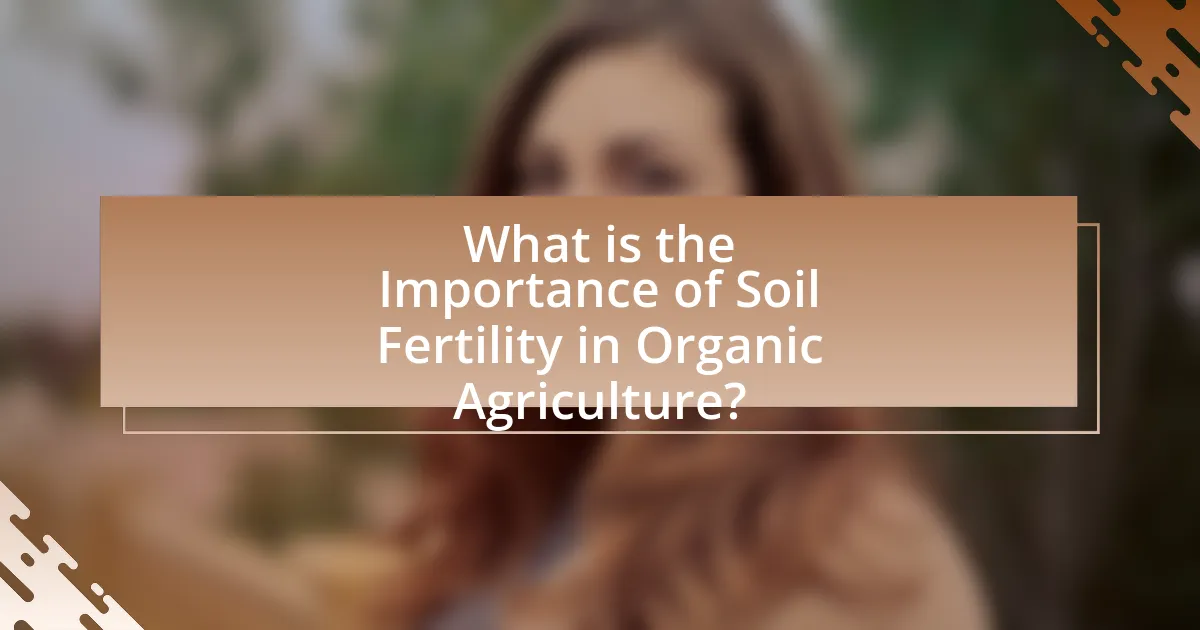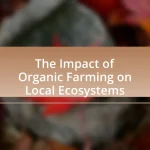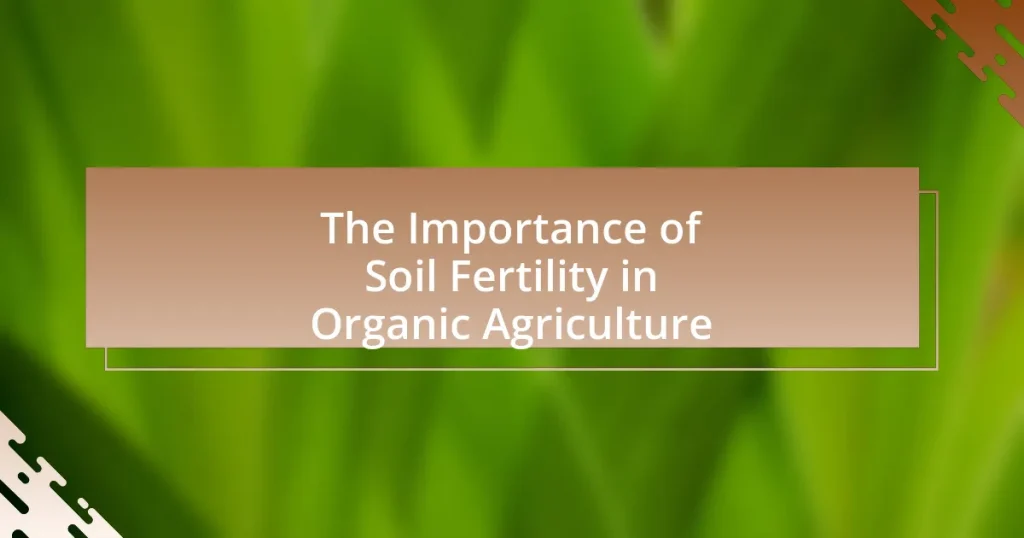Soil fertility is a fundamental aspect of organic agriculture, significantly impacting crop yield, plant health, and ecosystem sustainability. The article explores the critical components of soil fertility, including essential nutrients, organic matter, soil structure, and biological activity, and how these elements contribute to enhanced agricultural productivity. It highlights the importance of practices such as crop rotation, cover cropping, and composting in maintaining soil fertility, as well as the challenges farmers face, including nutrient depletion and environmental degradation. Additionally, the article discusses the long-term benefits of improved soil fertility for sustainable farming practices and economic advantages for farmers.

What is the Importance of Soil Fertility in Organic Agriculture?
Soil fertility is crucial in organic agriculture as it directly influences crop yield, plant health, and ecosystem sustainability. Healthy soil, rich in organic matter and nutrients, supports diverse microbial communities that enhance nutrient availability and soil structure. Research indicates that organic farming practices, such as crop rotation and composting, improve soil fertility, leading to increased productivity; for instance, a study published in the journal “Agriculture, Ecosystems & Environment” found that organic systems can yield 20% more than conventional systems in the long term due to enhanced soil health. Thus, maintaining soil fertility is essential for achieving sustainable agricultural practices and ensuring food security.
Why is soil fertility crucial for organic farming?
Soil fertility is crucial for organic farming because it directly influences crop yield, plant health, and ecosystem sustainability. Fertile soil contains essential nutrients, supports beneficial microorganisms, and enhances water retention, all of which are vital for the growth of organic crops. Research indicates that organic farming practices, which rely on maintaining soil fertility through natural amendments like compost and cover crops, can lead to higher biodiversity and improved soil structure. A study published in the journal “Agriculture, Ecosystems & Environment” by Reganold and Wachter (2016) found that organic farms often have better soil quality and higher levels of organic matter compared to conventional farms, demonstrating the importance of soil fertility in achieving sustainable agricultural practices.
What are the key components of soil fertility?
The key components of soil fertility are essential nutrients, organic matter, soil structure, and biological activity. Essential nutrients, including nitrogen, phosphorus, and potassium, are critical for plant growth and are often supplied through fertilizers or organic amendments. Organic matter enhances soil fertility by improving nutrient retention and water-holding capacity, while soil structure affects aeration and root penetration. Biological activity, driven by microorganisms and earthworms, contributes to nutrient cycling and soil health. These components collectively ensure that soil can support healthy plant growth, which is vital for successful organic agriculture.
How does soil fertility impact crop yield in organic agriculture?
Soil fertility significantly impacts crop yield in organic agriculture by providing essential nutrients that plants require for growth. Fertile soil enhances the availability of macronutrients like nitrogen, phosphorus, and potassium, which are crucial for plant development and productivity. Research indicates that organic farming practices, such as crop rotation and the use of compost, improve soil structure and nutrient content, leading to higher yields. For instance, a study published in the journal “Agriculture, Ecosystems & Environment” found that organic farms can yield up to 20% more than conventional farms when soil fertility is optimized through organic amendments. This demonstrates that maintaining high soil fertility is vital for maximizing crop yield in organic agriculture.
How does soil fertility influence ecosystem health?
Soil fertility significantly influences ecosystem health by determining the availability of essential nutrients for plant growth, which in turn supports diverse biological communities. Healthy, fertile soil promotes robust plant development, leading to increased biomass and productivity, which are critical for sustaining herbivores and higher trophic levels. Research indicates that nutrient-rich soils enhance microbial diversity and activity, which are vital for nutrient cycling and organic matter decomposition, further contributing to ecosystem stability and resilience. For instance, a study published in “Nature” by Smith et al. (2020) found that ecosystems with higher soil fertility exhibited greater biodiversity and productivity, demonstrating a direct correlation between soil health and overall ecosystem functionality.
What role does soil fertility play in biodiversity?
Soil fertility plays a crucial role in biodiversity by providing essential nutrients and a conducive environment for various organisms. Fertile soil supports a diverse range of plant species, which in turn sustains a variety of animal species, creating a balanced ecosystem. Research indicates that healthy soils with high organic matter content can enhance microbial diversity, which is vital for nutrient cycling and soil health. For instance, a study published in the journal “Soil Biology and Biochemistry” found that increased soil fertility correlates with higher plant diversity, which supports a broader range of herbivores and predators, thereby promoting overall biodiversity.
How does soil fertility affect water retention and quality?
Soil fertility significantly enhances water retention and quality by improving the soil’s structure and nutrient content. Fertile soils, rich in organic matter, have better aggregation, which creates more pore spaces for water storage and reduces runoff. Research indicates that soils with high organic matter can retain up to 20 times their weight in water, thereby increasing moisture availability for plants. Additionally, fertile soils support diverse microbial communities that contribute to nutrient cycling and the breakdown of pollutants, leading to improved water quality. Studies show that healthy, fertile soils can reduce leaching of harmful substances, thus protecting groundwater resources.
What practices enhance soil fertility in organic agriculture?
Practices that enhance soil fertility in organic agriculture include crop rotation, cover cropping, composting, and the use of organic fertilizers. Crop rotation improves soil structure and nutrient availability by alternating different crops, which helps prevent nutrient depletion and pest buildup. Cover cropping, such as planting legumes, adds organic matter and nitrogen to the soil, enhancing its fertility. Composting recycles organic waste into nutrient-rich material that improves soil health and structure. Organic fertilizers, derived from natural sources, provide essential nutrients without the harmful effects of synthetic chemicals, promoting a balanced ecosystem. These practices are supported by research indicating that organic farming methods can lead to improved soil quality and increased agricultural productivity.
How do cover crops contribute to soil fertility?
Cover crops enhance soil fertility by improving nutrient availability, organic matter content, and soil structure. They achieve this through processes such as nitrogen fixation, where legumes convert atmospheric nitrogen into a form usable by plants, thus enriching the soil. Additionally, cover crops increase organic matter as they decompose, which boosts microbial activity and nutrient cycling. Research indicates that cover crops can increase soil organic carbon levels by 0.1 to 0.4% annually, significantly contributing to overall soil health and fertility.
What is the role of compost in improving soil fertility?
Compost plays a crucial role in improving soil fertility by enhancing nutrient availability and soil structure. It enriches the soil with essential nutrients such as nitrogen, phosphorus, and potassium, which are vital for plant growth. Additionally, compost increases microbial activity, promoting a healthy ecosystem that aids in nutrient cycling. Research indicates that compost can improve soil organic matter content by 5-10%, leading to better water retention and aeration, which further supports plant health and productivity.
How can farmers assess soil fertility effectively?
Farmers can assess soil fertility effectively by conducting soil tests that analyze nutrient levels, pH, and organic matter content. Soil testing provides quantitative data on essential nutrients such as nitrogen, phosphorus, and potassium, which are critical for plant growth. According to the USDA, regular soil testing can help farmers make informed decisions about fertilization and soil amendments, ultimately enhancing crop yields and sustainability in organic agriculture.
What soil tests are essential for evaluating fertility levels?
Essential soil tests for evaluating fertility levels include pH testing, nutrient analysis (specifically nitrogen, phosphorus, and potassium), organic matter content assessment, and cation exchange capacity (CEC) measurement. These tests provide critical insights into soil health and nutrient availability, which are vital for optimizing crop production in organic agriculture. For instance, pH levels influence nutrient solubility, while nutrient analysis quantifies essential elements necessary for plant growth. Research indicates that maintaining balanced nutrient levels can enhance crop yields and soil sustainability, underscoring the importance of these tests in effective soil management practices.
How can farmers interpret soil test results for better management?
Farmers can interpret soil test results by analyzing key nutrient levels, pH, and organic matter content to make informed management decisions. Understanding the nutrient levels, such as nitrogen, phosphorus, and potassium, allows farmers to determine if their soil meets crop needs or requires amendments. The pH level indicates soil acidity or alkalinity, which affects nutrient availability; for instance, a pH between 6.0 and 7.0 is generally optimal for most crops. Additionally, assessing organic matter content helps farmers gauge soil health and its capacity to retain moisture and nutrients. By correlating these factors with crop requirements, farmers can tailor their fertilization and soil management practices, ultimately enhancing soil fertility and crop yields in organic agriculture.
What challenges do farmers face regarding soil fertility?
Farmers face several challenges regarding soil fertility, including nutrient depletion, soil erosion, and contamination from chemicals. Nutrient depletion occurs when crops are harvested without adequate replenishment of essential minerals, leading to reduced soil productivity over time. Soil erosion, often exacerbated by poor land management practices, removes the topsoil rich in nutrients, further diminishing fertility. Additionally, contamination from pesticides and fertilizers can disrupt soil microbiomes, negatively impacting nutrient availability and overall soil health. According to the Food and Agriculture Organization, approximately 33% of the world’s soil is degraded, highlighting the urgency of addressing these challenges for sustainable agricultural practices.
How do pests and diseases affect soil fertility?
Pests and diseases negatively impact soil fertility by disrupting the balance of soil microorganisms and depleting essential nutrients. When pests infest plants, they can lead to reduced plant health, which in turn affects root systems and their ability to contribute organic matter to the soil. Diseases can cause plant death or stunted growth, limiting the organic inputs that enhance soil structure and nutrient availability. Research indicates that soil health is closely linked to plant diversity; for instance, monocultures are more susceptible to pests and diseases, leading to greater soil degradation. Therefore, the presence of pests and diseases can significantly diminish soil fertility, ultimately affecting agricultural productivity.
What environmental factors can degrade soil fertility?
Environmental factors that can degrade soil fertility include erosion, salinization, compaction, and contamination. Erosion removes the topsoil, which is rich in nutrients, leading to decreased fertility. Salinization occurs when water evaporates from the soil, leaving salts behind that can harm plant growth. Soil compaction reduces pore space, limiting root growth and water infiltration, which negatively impacts nutrient availability. Contamination from pollutants, such as heavy metals and pesticides, can also disrupt soil microbial communities essential for maintaining soil health. These factors collectively contribute to a decline in soil fertility, affecting agricultural productivity and ecosystem health.
What are the long-term benefits of maintaining soil fertility in organic agriculture?
Maintaining soil fertility in organic agriculture leads to enhanced crop yields and improved soil health over the long term. Healthy soil supports diverse microbial communities, which contribute to nutrient cycling and disease suppression. Research indicates that organic farming practices, such as crop rotation and cover cropping, can increase soil organic matter by 1-2% annually, significantly boosting soil fertility. Additionally, studies show that maintaining soil fertility reduces the need for synthetic fertilizers, thereby lowering production costs and minimizing environmental impact. These practices contribute to sustainable agricultural systems that can endure climate variability and promote biodiversity.
How does soil fertility contribute to sustainable farming practices?
Soil fertility significantly contributes to sustainable farming practices by enhancing crop yields and promoting ecological balance. Fertile soil contains essential nutrients, organic matter, and beneficial microorganisms that support plant growth and resilience against pests and diseases. Research indicates that maintaining soil fertility through practices such as crop rotation, cover cropping, and organic amendments can increase soil organic carbon levels, which improves soil structure and water retention. For instance, a study published in the journal “Agriculture, Ecosystems & Environment” found that organic farming systems with high soil fertility can yield comparable or even higher outputs than conventional systems while reducing the need for chemical fertilizers. This demonstrates that soil fertility is crucial for achieving sustainable agricultural productivity and environmental health.
What economic advantages arise from improved soil fertility?
Improved soil fertility leads to increased agricultural productivity, which directly enhances farmers’ income. Higher yields from fertile soil reduce the cost per unit of production, allowing farmers to achieve better profit margins. For instance, research indicates that organic farming practices that enhance soil fertility can increase crop yields by 20-30% compared to conventional methods. Additionally, improved soil health can lower the need for chemical fertilizers and pesticides, resulting in cost savings for farmers. This economic advantage is supported by studies showing that sustainable soil management practices can lead to a 10-15% reduction in input costs while maintaining or increasing crop output.
What practical tips can farmers implement to enhance soil fertility?
Farmers can enhance soil fertility by implementing practices such as crop rotation, cover cropping, and the application of organic amendments like compost and manure. Crop rotation prevents nutrient depletion and disrupts pest cycles, while cover cropping improves soil structure and adds organic matter. The use of compost and manure enriches the soil with essential nutrients, promoting microbial activity and overall soil health. Research indicates that these practices can significantly increase soil organic matter and nutrient availability, leading to improved crop yields and sustainability in organic agriculture.










